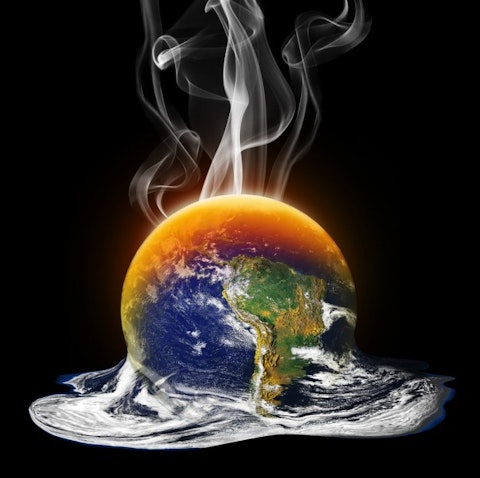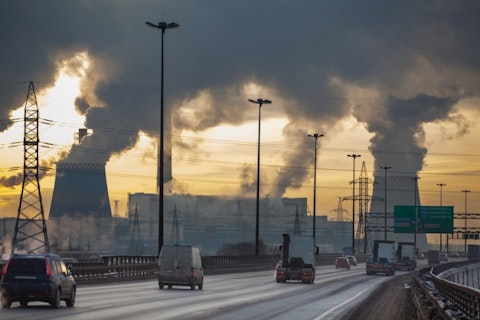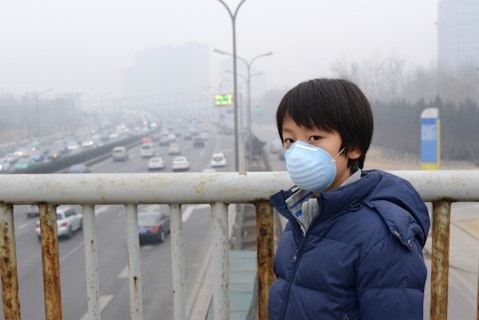We live in a world that is fast changing and we’re not talking about technology or the geopolitics, but rather about the rapid climate changes that are taking place, partly because of because of these 11 worst countries that are responsible for global warming.
Of course, there are many elements that lead to global warming, but the heavy pollution that’s characteristic of our day and age has certainly hurried the natural cycle of heating and cooling that the planet goes through. In short, carbon dioxide and other global warming pollutants are collecting in the atmosphere, building a sort of blanket that doesn’t let out the sun’s heat. This, in turn, causes the planet to warm up at a rapid pace.

Barnaby Chambers/Shutterstock.com
A fluctuation of temperatures is perfectly normal, but in the past few decades, the average global temperature increased at such a rapid pace that we’re now way ahead of schedule, in a manner of speaking. Recently, the whole world came together and signed an agreement to lower pollution levels in order to slow down the effects of global warming, but whether or not the measures will actually be applied remains to be seen, just as it remains to be seen whether or not they’ll be effective in their purpose. It’s a gamble that we should take, unlike the people living in these 11 countries with the highest gambling losses in the world.
All countries pollute, but some emit higher levels of carbon dioxide than others. For today’s list, we took a look at the levels of CO2 published by the Emission Database for Global Atmospheric Research. Since the 2015 numbers aren’t yet available, we’re going to take into account the 2014 emission totals. Without further ado, here are the 11 worst countries that are responsible for global warming.
11. Saudi Arabia
Emissions – 494,822.17 Ktons CO2
The country with the world’s largest oil reserves and an economy almost exclusively based on the export of fossil fuels, Saudi Arabia holds a controversial position regarding climate change. Over the years, it was accused of trying to block anti-climate change measures, mostly in order to protect its economy. More recently, however, the country announced that it plans to diversify its economy in order to help combat climate change. The government set its target at 130 million tonnes of carbon emissions by 2030, which means impressive measures are to be taken in the next 14 years in order to reach these numbers.

Fedor Selivanov / Shutterstock.com
10. Brazil
Emissions – 501,102.85 Ktons CO2
Brazil holds an interesting position when it comes to global warming. On one hand, it occupies the tenth position among the world’s countries responsible for global warming as one of the largest economies. On the other hand, it is the home of one of the greatest ecosystems and forests – the Amazon. While things have been going better in the past years as the country dropped a few spots on the list, mostly thanks to slowing down deforestation efforts, 500 million tonnes of CO2 is still a lot, no matter what you compare them to. As one of the countries that are most responsible for global warming, Brazil faces big threats, including regarding the state of the rainforest.

Spectral-Design/Shutterstock.com
9. Canada
Emissions – 565,991.53 Ktons CO2
While Canada may be guilty of quite a bit of pollution, at least, it tries to do something about it. The country’s new prime minister has taken a more proactive stance towards the issue, vowing to do more than it has up until now. “We have an opportunity to make history in Paris – an agreement that supports a transition to a low-carbon economy that is necessary for our collective health, security, and prosperity,” said Prime Minister Justin Trudeau back in November.
The Canadian government plans to work with scientists and follow their advice based on the available evidence regarding global warming. It wants to implement policies that contribute to a low-carbon economy, including carbon pricing. As climate change effects become more acute, the Canadian forests are said to be among the most vulnerable, which would affect countless species and ecosystems. The meltdown of the ice sheets and glaciers can be added to the list of how Canada is being affected by the changes in climate.

Andy.M/Shutterstock.com
8. South Korea
Emissions – 610,065.60 Ktons CO2
With all the factories running in Korea, the country’s emissions are increasingly high. 610 million tonnes of CO2 emissions in 2014 is a really big number and one that affects the local climate as well as the global situation. Various pollutants and greenhouse gases caused by the industrialisation of the area, as well as the population increase, have impacted the country in many ways. For instance, the annual temperature has modified, rainfall amounts have changed, precipitations have suffered changes too. The record minimum temperature has decreased, while maximum precipitation during the summer has increased.
The country has a plan to reduce greenhouse gas emissions by 37 percent by 2030. Without the measures they plan to take in the next 14 years, Korea’s emissions are projected to reach 850.6 million tonnes of carbon dioxide, which is something they plan not to let happen.

7. Iran
Emissions – 618,197.22 Ktons CO2
While some believe that global warming is not real, there are many areas of the globe where the effects are already being seen. Heatwaves have been more frequent in Iran, for instance. The situation is so dire that by 2100, if carbon emissions aren’t cut, the Iranian coast, Qatar, Dubai and other areas nearby could become unlivable. One study published in Nature Climate Change indicates that climate change could hike up the temperatures in the area to a point where, without air conditioning, humans could last about six hours before their bodies began to shut down, making any kind of outdoor activity nearly impossible. Agriculture, construction, transportation and aquaculture could become hazardous under these circumstances.

anekoho/Shutterstock.com
6. Germany
Emissions – 767,145.57 Ktons CO2
Europe’s country with the largest greenhouse gas emissions may have put over 767 million tonnes of CO2 into the atmosphere in 2014 alone, but that doesn’t mean it has no plans to tackle the situation. In fact, it has been working hard to change its main source of energy to renewable sources. Last year, Germany announced that 78 percent of all the country’s electricity comes from renewable energy sources.
Along with the other plans it has to lower its CO2 emissions, Germany sets an example to other countries, showing them that it can be done and that the world’s climate matters. The country’s emissions are dropping and the trend will, hopefully, continues in the years to come. After all, Germany plans to cut greenhouse emissions by 40 percent by 2020 and up to 95 percent by 2050, switching to renewable energy in all sectors.

5. Japan
Emissions – 1,278,921.81 Ktons CO2
Now that’s a big jump between the sixth and the fifth places in this chart that no one wants to be on. Japan’s carbon dioxide emissions reached 1.2 billion tonnes in 2014, which is a huge number. Not only is Japan one of the world’s biggest contributors to global warming, but it is also one of the nations that are most affected by the changes in climate. Extreme heat, storms and rising water levels are only some of the effects already making themselves known in Japan.
By 2030, Japan wants to lower its carbon dioxide emissions by 26 percent.

Sakarin Sawasdinaka/Shutterstock.com
4. Russia
Emissions – 1,766,427.27 Ktons CO2
With as close to the Arctic as Russia is, the country runs big risks in case of an acceleration of global warming. Climate change is already being felt in Russia’s many corners, especially given how massive the country really is. Nevertheless, Russia’s governments have taken it upon themselves to run politics that seek to lower the greenhouse gas emissions as much as possible. So far, they’ve been somewhat successful. Back in 1990, Russia’s CO2 emissions reached 2.3 billion tonnes, which is considerably more than the 1.7 billion tonnes it put into the atmosphere in 2014. Nowadays, Russia vows to keep its plan to keep its greenhouse gas emissions at 25-30 percent below the 1990 levels.

Kekyalyaynen / Shutterstock.com
3. India
Emissions – 2,341,896.77 Ktons CO2
One of the world’s largest countries is also one of the nations that contribute to global warming the most. With 2.3 billion tonnes of CO2 emissions in 2014, India places third on the list no one wants to be on. Thankfully, India has a plan similar to that of other states, looking to lower its greenhouse gas emissions by 33 to 35 percent from 2005 levels by 2030. The government also put the same deadline on drawing more of its energy from renewable sources, setting 40 percent as the target.

Kunal Mehta / Shutterstock.com
2. United States
Emissions – 5,334,529.74 Ktons CO2
Despite whatever conspiracy theorists want you to believe, global warming is real and it’s happening everywhere in the world and the United States is one of the countries that holds most of the responsibility. In fact, in 2014, it put over 5.3 billion tonnes of CO2 into the atmosphere. For comparison’s sake 28 European Union member states only generated 3.4 billion tonnes of CO2 in the same year.
As if it finally awakened from a deep sleep, the United States has put forward an ambitious proposal, seeking to cut carbon dioxide emissions by 32 percent from 2005 levels by 2030, increasing its renewable energy usage by 30 percent by the same year.

Joseph Sohm / Shutterstock.com
1. China
Emissions – 10,540,749.59 Ktons CO2
It’s no surprise just who tops the list of the worst kids on the block when it comes to pollution. Frankly, if you’ve watched the news in the past few months you already know that there are days when people in some Chinese cities don’t even get to see the sky due to all the smog. It’s a troublesome situation when you have to wear a mask just to get out of the house because the air is not breathable, but that’s the case for millions and millions of people in China. According to research, air pollution in China causes 1.6 million premature deaths every year.
CO2 emissions in China have been above 9 billion tonnes since 2010, despite the country’s efforts to portray itself as one of the biggest combatants of global warming. So far, the country wants to put into practice a new national cap-and-trade system to limit carbon emissions, starting in 2017. Officials have also said that its CO2 emissions would peak sometime around 2030, and possibly earlier, while also looking to increase the fraction of energy from renewable resources from 11 percent to 20 percent by 2030. Either way, China is by far the number one member on the list of the 11 worst countries that are responsible for global warming.

Hung Chung Chih/Shutterstock.com





